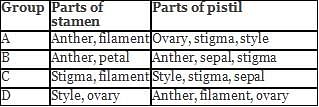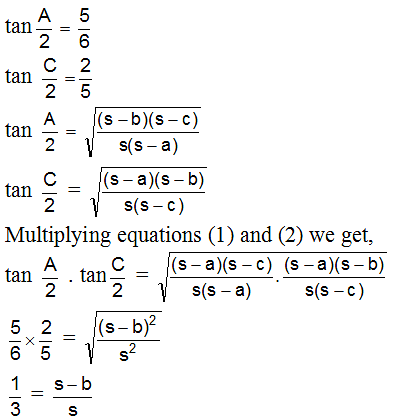AP TET Paper 2 Mock Test - 8 (Science and Mathematics) - AP TET MCQ
30 Questions MCQ Test - AP TET Paper 2 Mock Test - 8 (Science and Mathematics)
According to the theory of Bruner, which of the following statements is correct?
Self-study habit can be developed in children by
Which of the following is the most important function of language?
According to Piaget's stages of cognitive development, with whom the 'sensory-motor state' is related?
What does the term 'PSRN' in development imply?
A teacher can respond to the interests of children with special needs by:
किसी उत्पाद का इस्तेमाल करके उपभोक्ता भी बाजार में भागीदार बन जाता है। यदि उपभोक्ता नही होंगे तो किसी भी कंपनी का अस्तित्व नही होगा। जहाँ तक उपभोक्ता के अधिकार का सवाल है तो उपभोक्ता की स्थिति दयनीय ही कही जायेगी। इसको समझने के लिए आप वैसे दुकानदार का उदाहरण ले सकते है जो कम वजन तौलता है या वह कम्पनी जो अपने पैक पर झूठे वादे करती है। ज्यादातर मिठाई बेचने वाले कच्चे माल में मिलावट करके लड्डू या बर्फी बनाते है। कुछ वर्षो पहले मिलावटी सरसों तेल से फैलने वाली ड्रॉप्सी नाम की बीमारी आपको याद होगी। यदि आपने कभी ट्रेन से सफर किया होगा तो आपको पता होगा कि ट्रेन में बिकने वाले खाने पीने की ज्यादातर चीजे घटिया होती है। यहाँ तक की पैंट्री में मिलने वाला खाना भी घटिया क्वालिटी का होता है। भारत में मिलावट, कालाबाजारी, जमाखोरी, कम वजन आदि की पुरानी परम्परा रही है। 1960 के दशक से भारत में उपभोक्ता आन्दोलन शुरू हुए थे। 1970 के दशक तक उपभोक्ता आन्दोलन केवल आर्टिकल लिखने और प्रदर्शनी लगाने तक ही सीमित था। लेकिन हाल के वर्षो में उपभोक्ता संगठनों की संख्या में तेजी से उछाल आया है।
विक्रेताओं और सेवा प्रदाताओं से लोगो में इतनी अधिक असंतुष्टि थी कि उपभोक्ताओं के पास अपनी आवाज उठाने के सिवा और कोई रास्ता नही बचा था। कई वर्षो के लम्बे संघर्ष के बाद सरकार को इसकी खैर लेने के लिए बाधित होना पड़ा और इसकी परिणति के रूप में 1986 में कंज्यूमर प्रोटेक्शन एक्ट (कोपरा) को लागू किया गया। एक उपभोक्ता को किसी उत्पाद के बारे में सही जानकारी पाने का अधिकार होता है। अब ऐसे कानून है जो किसी उत्पाद के पैक पर अवयवों और सुरक्षा के बारे में जानकारी देना अनिवार्य बनाते है। सही सूचना से उपभोक्ता को किसी भी उत्पाद को खरीदने के लिए उचित निर्णय लेने में मदद मिलती है। किसी भी उत्पाद के पैक पर खुदरा मूल्य लिखना भी अनिवार्य होता है। यदि कूई दुकानदार एमआरपी से अधिक चार्ज करता है तो उपभोक्ता उसकी शिकायत कर सकता है। एक उपभोक्ता को विभिन्न विकल्पों में से चुनने का अधिकार होता है। कोई भी विक्रेता केवल एक ही ब्रांड पेश नही कर सकता है। उसे अपने ग्राहक को कई विकल्प देने होगे। इस अधिकार को मोनोपोली ट्रेंड के खिलाफ बने कानूनों के जरिये लागू किया जाता है।
Q. अधिकारों के मामले में भारतीय उपभोक्ताओं की स्थिति कैसी है?
निर्देश: निम्नलिखित पद्यांश को ध्यानपूर्वक पढ़िए व प्रश्नों के उत्तर दीजिये:
पूछता क्यों शेष कितनी रात ?
अमर सम्पुट में ढला तू,
छू नखों की कांति चिर संकेत पर जिन के जला तू,
स्निग्ध सुधि जिन की लिये कज्जल-दिशा में हँस चला तू!
परिधि बन घेरे तुझे वे उँगलियाँ अवदात !
झर गए खद्योग सारे;
तिमिर-वात्याचक्र में सब पिस गये अनमोल तारे,
बुझ गई पवि के हृदय में काँप कर विद्युत-शिखा रे !
साथ तेरा चाहती एकाकिनी बरसात !
व्यंगमय है क्षितिज-घेरा
प्रश्नमय हर क्षण निठुर-सा पूछता परिचय बसेरा,
आज उत्तर हो सभी का ज्वालवाही श्वास तेरा !
छीजता है इधर तू उस ओर बढ़ता प्रात !
Q. ‘रात’ शब्द के उचित पर्यायवाची पंक्ति को बताइए।
Direction: Read the passage given below and then answer the questions given below the passage. Some words may be highlighted for your attention.
The big fuss about consensus management is an issue that boils down to a lot of noise about not much. The consensus advocates are great admirers of the Japanese management style. Consensus is what Japan is famous for. Well, I know the Japanese fairly well: They still remember Douglas MacArthur with respect, and they still bow down to their Emperor. In my dealings with them, I found that they talk a lot about consensus, but there's always one guy behind the scenes who ends up making the tough decisions. It doesn't make sense to me to think that Mr. Toyoda or Mr. Morita of Sony sits around in committee meetings and says, "We've got to get everybody in this organization, from the janitor up, to agree with this move". The Japanese believe in their workers' involvement early on in the decision-making process and in feedback from employees. And they probably listen better than we do. But you can bet that when the chips are down, the yen stops at the top guy's desk. So, we're wasting time trying toDirection: Read the passage given below and then answer the questions given below the passage. Some words may be highlighted for your attention.
The big fuss about consensus management is an issue that boils down to a lot of noise about not much. The consensus advocates are great admirers of the Japanese management style. Consensus is what Japan is famous for. Well, I know the Japanese fairly well: They still remember Douglas MacArthur with respect, and they still bow down to their Emperor. In my dealings with them, I found that they talk a lot about consensus, but there's always one guy behind the scenes who ends up making the tough decisions. It doesn't make sense to me to think that Mr. Toyoda or Mr. Morita of Sony sits around in committee meetings and says, "We've got to get everybody in this organization, from the janitor up, to agree with this move". The Japanese believe in their workers' involvement early on in the decision-making process and in feedback from employees. And they probably listen better than we do. But you can bet that when the chips are down, the yen stops at the top guy's desk. So, we're wasting time trying to emulate something I don't think really exists.
Business structures are microcosms of other structures. There were no corporations in the fifteenth century. But there were families. There were city governments, provinces, and armies. There was the Church. All of them had, for lack of a better word, a pecking order.
Why? Because that's the only way you can steer clear of anarchy. Otherwise, you'll have somebody come in one morning and tell you: "Yesterday I got tired of painting red convertibles, so today I switched to all baby-blues on my own". You'll never get anything done right that way.
What's to admire about consensus management anyway? By its very nature, it's slow. It can never be daring. There can never be real accountability - or flexibility. About the only plus that I've been able to figure out is that consensus management means consistency of direction and objectives. And so much consistency can become faceless, and that's a problem too. In any event, I don't think it can work in this country. The fun of business for entrepreneurs, big or small, lies in the free enterprise system, not in the greatest agreement by the greatest number.
Business structures are microcosms of other structures. There were no corporations in the fifteenth century. But there were families. There were city governments, provinces, and armies. There was the Church. All of them had, for lack of a better word, a pecking order.
Why? Because that's the only way you can steer clear of anarchy. Otherwise, you'll have somebody come in one morning and tell you: "Yesterday I got tired of painting red convertibles, so today I switched to all baby-blues on my own". You'll never get anything done right that way.
What's to admire about consensus management anyway? By its very nature, it's slow. It can never be daring. There can never be real accountability - or flexibility. About the only plus that I've been able to figure out is that consensus management means consistency of direction and objectives. And so much consistency can become faceless, and that's a problem too. In any event, I don't think it can work in this country. The fun of business for entrepreneurs, big or small, lies in the free enterprise system, not in the greatest agreement by the greatest number.
Q. Explain: 'when the chips are down'.
The term 'linguistic competence' is associated with which one of the following approaches/methods to ELT?
Bengali language is associated with which language family?
The two-word stage of language acquisition which is also known as telegraphic speech includes words like:
I. mim-mim-mai-yaaaaa, ba-ba-ga-ga
II. mummii khaanaa, ghuumii jaana
Language errors should be corrected when the goal is______.
Directions: Identify the antonym of the underlined word in the following sentence.
At school, the boy had erratic behaviour.
If in a  , tan
, tan  , tan
, tan  , then
, then
Consider the following statements:
(i) Air is a homogeneous mixture.
(ii) 24 carat gold is an alloy of gold and copper.
(iii) Amalgam is an alloy.
Which of the following options is correct?
A sum of money at simple interest tripled in 10 years. In how many years, at the same rate, will it be five times?
Study the following table:

The group in which the parts of stamen and parts of pistil are correctly shown is
Let the focal length of an eye-piece be 2.5 cm. For a telescope of magnification 100, the focal length of the objective should be:
Given below are two statements, one labelled as Assertion (A) and the other as Reason (R)
Assertion (A): Sunflower oil is rated as a good quality of edible oil.
Reason (R): It contains high quantities of unsaturated fatty acids.
Select the correct answer from the codes given below:
Codes:
If 20 percent of P is added to 40 percent of Q, then the resultant comes as 80 percent of Q. P is what percentage of Q?
Which of the following provides quantitative as well as qualitative descriptions of the outcomes of teaching-learning process?
Which of the following statement is\are true?
I. Assessment in science should be based on rote memory.
II. Assessment in science promotes scientific inquiry.
Raghav can split and recombine fractions mentally to add or subtract as

In which developmental stage of numbers does Raghav lies?
Which of the following is not a mineral acid?
Characteristic of simplicity relates to which of the following?
"Science is the investigation and interpretation of events or phenomenon that occurs in natural environment and within our own body."
The above-mentioned definition of Science is given by
An agricultural graduate with his new thoughts invented a paddy-drying equipment which dries up paddy in less cost and in less time. The biological science teaching value involved in this is
Which of the following is not among various qualities of processes of scientific inquiries?





















